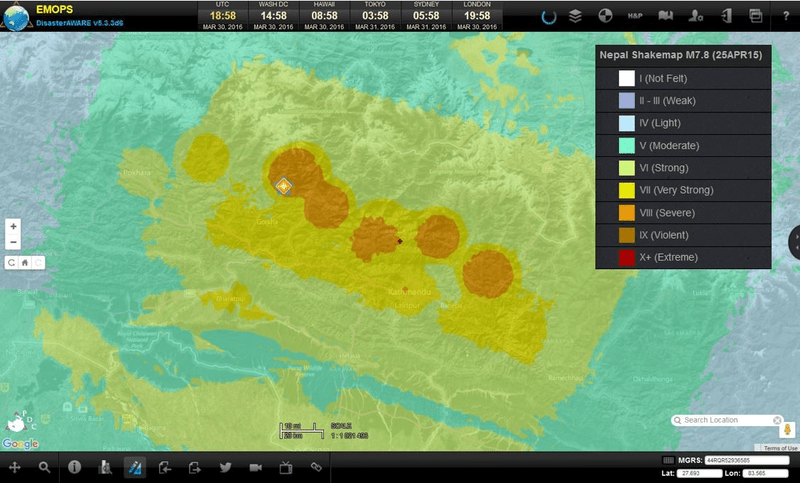The violent shaking caused by the 7.8M earthquake on April 25, 2015, and the major aftershocks that followed, claimed nearly 9,000 lives, severely damaged critical infrastructure, and left a wide-range of major social, economic, and environmental challenges in their wake in the densely populated Kathmandu Valley. According to the Government of Nepal 602,592 houses were destroyed and 284,482 were damaged (WFP), leaving several hundreds of thousands people in need of temporary shelter.
At the onset, as the international community rushed to assist with this humanitarian crisis, Pacific Disaster Center (PDC) began to map various aspects of the disaster-affected areas, focusing on factors relevant to rescue, relief, and response. Working directly with the Government of Nepal and the international response community, PDC issued over 140 key products and reports visualizing data such as damage and impact, urban search and rescue, risk and vulnerability, health, shelter and displaced populations, and additional threats to the relief operations, like heavy rainfall, flooding, and landslides. Yet, the end of response operations did not bring an end to the suffering.
Through the months, PDC’s all-hazard warning and decision support tool, DisasterAWARE, has provided access to critical information and updates on the event, and has served as a common operating picture for the coordination of recovery operations.
A year later, survivors, especially those residing in the rural areas surrounding Kathmandu, continue to face daily hardships as they work toward family and community recovery. During this time humanitarian agencies have continued to provide relief assistance and to address the needs of affected people. Their efforts, however, have been hampered by disruptions in the supply and distribution of fuel, gas, and consumables (IOM).
Access to remote mountain villages in Nepal—difficult even prior to the quake—was severely impacted, and has remained extremely troublesome, increasing the impact on the most vulnerable people by limiting their access to assistance. Over the winter months, villagers have faced subzero temperatures in inadequate shelters, and threats of landslides have continued to require relocation of communities (AFP). As of March 2016, more than 200,000 families remain in temporary shelters at high altitudes where snow began falling last November (AAH). In addition, food security and access to medical supplies continues to be threatened (FAO).
The severity and extent of damage caused by the 2015 earthquake placed the PDC on full activation. Situational awareness products, such as this one, were generated and disseminated around the clock to help communities and responders more quickly mobilize the right resources to protect lives and reduce losses.
Many people in Nepal remain committed to rebuilding and strengthening the country for the future. For example, as many as 2,000 masons are being trained in building earthquake-resilient buildings—many of them were unaware of these techniques prior to the earthquake (TKP). Furthermore, partnership and planning are playing important roles in resolving challenges and reducing future impacts of hazards (IFRC).
Indeed, disaster reduction does not end with response. As recovery efforts continue in Nepal, PDC remains engaged and ready to support the government of Nepal and its international and national partners, as necessary. In fact, today, more than 375 PDC products are available to qualified recovery professionals. Additionally, in partnership with USACE, PDC has advanced interagency information sharing in direct support of hazard modeling, risk assessment, and disaster early warning and notification in the country. Through this partnership, the team is also strengthening data collection capacities within the nation, hoping to enhance local expertise in this subject matter. Most of the information resources prepared by PDC have been made available through EMOPS (Emergency Operations), the customized version of DisasterAWARE for disaster managers and humanitarian assistance practitioners, which provides access to information about Nepal’s current and historical hazards and impacts, population and environmental characteristics, infrastructure, risk and vulnerability profile, and more.
To find out more, please contact info@pdc.org.
Learn more:
- Find PDC products about the 7.8M earthquake,
- Read about a 2014 Disaster Response Exercise in Nepal, or
- Visit ReliefWeb for additional sources and links.
- View the PDC Multi hazard Response and/or DisasterAWARE fact sheets.
Additional PDC news regarding the 7.8M earthquake in Nepal:
- Relief to Severely Impacted Remote Villages Hampered by Inaccessibility, Adverse Weather Conditions
- Preparedness Efforts Help Support Response in Nepal
- Initial Damage and Needs Assessment in Nepal
- Food Security Concerns in Nepal Grow as Demands Exceed In-Country Supply
- Health Care Resources Stretched Beyond Capacity by Earthquake Injuries
- Data Access for Supporting Response and Recovery in Nepal
- Critical Data on Infrastructure in Nepal as Death Toll Rises
- 7.8M Earthquake Strikes Nepal, Followed by Aftershocks

